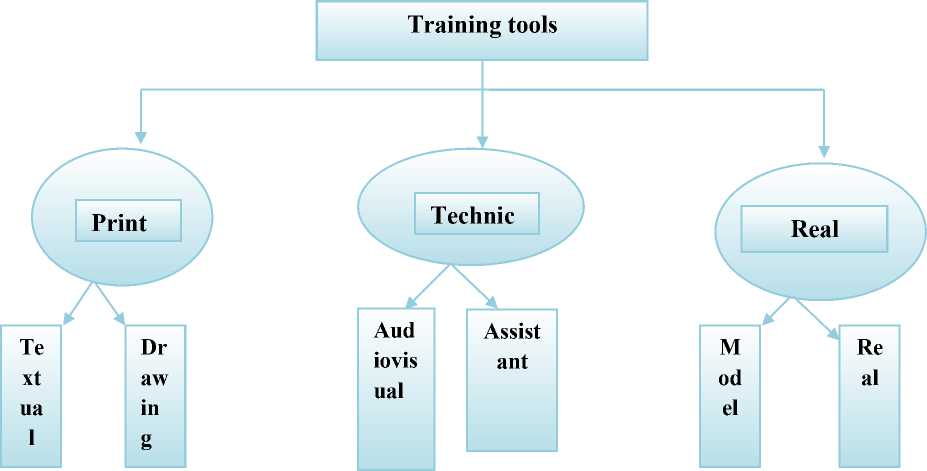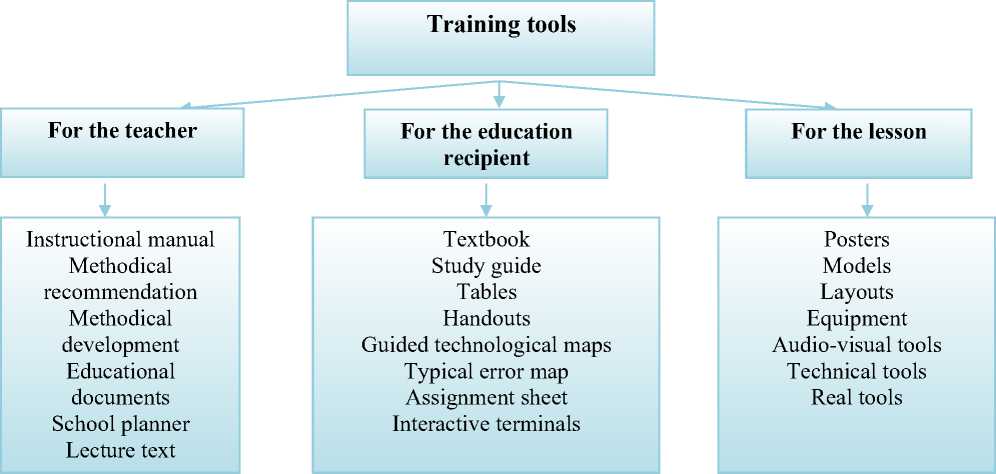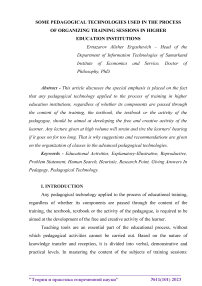Some pedagogical technologies used in the process of organizing training sessions in higher education institutions
Автор: Ernazarov A.E.
Журнал: Теория и практика современной науки @modern-j
Рубрика: Основной раздел
Статья в выпуске: 11 (101), 2023 года.
Бесплатный доступ
This article discusses the special emphasis is placed on the fact that any pedagogical technology applied to the process of training in higher education institutions, regardless of whether its components are passed through the content of the training, the textbook, the textbook or the activity of the pedagogue, should be aimed at developing the free and creative activity of the learner. Any lecture given at high volume will strain and tire the learners' hearing if it goes on for too long. That is why suggestions and recommendations are given on the organization of classes in the advanced pedagogical technologies.
Educational activities, explanatory-illustrative, reproductive, problem statement, human search, heuristic, research point, giving answers in pedagogy, pedagogical technology
Короткий адрес: https://sciup.org/140303664
IDR: 140303664
Текст научной статьи Some pedagogical technologies used in the process of organizing training sessions in higher education institutions
Any pedagogical technology applied to the process of educational training, regardless of whether its components are passed through the content of the training, the textbook, textbook or the activity of the pedagogue, is required to be aimed at the development of the free and creative activity of the learner.
Teaching tools are an essential part of the educational process, without which pedagogical activities cannot be carried out. Based on the nature of knowledge transfer and reception, it is divided into verbal, demonstrative and practical levels. In mastering the content of the subjects of training sessions:
explanatory-illustrative, reproductive, problem statement, heuristic search or heuristic and semi-research methods are used.
Oral methods of education include: lecture, conversation. When using them, the pedagogue describes and explains the educational material in a voice, and the students actively accept it by listening and memorizing it.
-
II. LITERATURE REVIEW
The following scholars have considered some pedagogical technologies used in the process of organizing training sessions in higher education institutions in their research: Avliyakulov N.Kh. [1], Allan Carrington [2], [4], Klarin M.V. [3], [5], Korostyleva N.Ya. [6], Kuzmina N.V. [7], Lebedev O.E. [8], Levites D.G. [9], Lutfillaev M.Kh. [10], Mavlyanov A. Abdalova C. Ernazarov A. [11], Ernazarov A.E. [12], [13], [14], [15].
-
III. RESEARCH METHODOLOGY
In this research, we used methods of logical analysis and synthesis, grouping, comparative and structural analysis, abstraction, factor analysis, induction and deduction.
-
IV. ANALYSIS AND RESULTS
Lecture is a common form of teaching and takes a leading place in pedagogical activity. Pedagogical methods such as oral presentation of the knowledge given during the lecture, holding the attention of students for a long time, activating their thoughts, proving, defining, bringing to a system, summarizing are used. The subjects are usually presented more in the form of lectures. Because such courses will have a more theoretical or generalizing character. During its organization, the pedagogue should emphasize the important aspects of science. In the lecture, the educational material is learned quickly and easily. If didactic purposes such as memorization, categorization, definition, evaluation, and explanation should be implemented during the course of the training session, it is certainly appropriate to organize training sessions in the form of a lecture. The lecture material related to life, daily life, and important events is easily assimilated. It is also important that theoretical knowledge and information of worldview importance are given with the help of a lecture. Any lecture given at high volume will strain and tire the learners' hearing if it goes on for too long That's why advanced pedagogical technologies will be used for the lectures organized in Acoc. The speaker divides his speech into several parts. Each part lasts 15-20 minutes and after each block there is a question-and-answer session During the lecture, some problems will be revealed. During this period, the attitude of learners to this problem is determined, their opinions are listened to. The lecturer should monitor the growth of interest, aspiration, and responsibility of the learners, and during this time, he should encourage the active participants. It is appropriate to make a technological map of the lecture for the training.
Table 1
Technological map of the lecture
|
Jobj a regions |
Faprocess content Teacher |
Learner |
|
1st step . Enter ( 20 minutes) |
|
1. He listens. 2,3,4. He looks at the OUM. 5. Writes down the name of the topic. 6. Expresses a free opinion. |
|
2nd step I 'm hungry ( 50 minutes) |
|
|
|
3rd step. Final . ( 10 minutes) |
|
1. Education — _receiverlistens , writestakes _ 2 . Assignmenttake it 3. Listen and say . 4. Listen and sayand |
I I I O' UM looks _ I
With the help of well-thought-out puzzles, the conversational tip allows for a conversation between the pedagogue and the students, and leads their independent thinking to acquire new concepts and laws. In its application, it is used to ask questions, discuss answers and opinions of learners, form conclusions, and correct answers.
In practice, setting a task (goal), planning the way to accomplish it, managing the execution process, analyzing, determining the cause of deficiencies, and making corrections and changes to the training process in order to fully achieve the goal are carried out. During practical exercises, learners actively observe their future actions, speak aloud to themselves, and interpret the future event. This helps the learners to realize their mistake and make corrections to their behavior.
Practical methods are used in close connection with the process of expressing education through words and strengthening it with demonstrative methods, in which the pedagogue gives an explanation and shows before performing the exercise, training, work operation. Verbal explanation and visual demonstration are usually carried out simultaneously with the exercise itself. In the following years, frontal laboratory work took a strong place in the educational process.
Discussion tip. Most subjects and their subjects require discussion-type teaching activities depending on the educational standards, subject materials, curriculum and educational needs, and in relation to the contingent of learners. In this case, the activity of learners is ensured, there is no room for suspicious situations, their wishes are fully satisfied, the most important thing is that the educational materials are fully mastered, the lessons and conclusions are in perfect form and content. There are guided and free discussion types. In the guided discussion, the participation of the pedagogue is significant. Free discussion is conducted with democratic participation of eca pedagogues and learners. The pedagogue should plan the outcome of the discussion in advance. The fact that the final conclusions contradict the theorist of scientific knowledge is provided by the professional skill of the pedagogue. The success of the discussion depends on the interest and knowledge of the learners.
Group work tip. It is a popular overseas teaching tip. For example, in Denmark, no information or group work is taken. The participation of low-income learners in some important educational activity and their cooperative activities determine the camaraci of such an activity. The level of performance and its quality is controlled by the pedagogue. Based on pedagogical goals and tasks, such groups are formed for emergencies.
A problematic assignment tip. Depending on the specific situation and the nature of the task at hand, camara can be achieved using challenging tasks. It is useful to create a problem situation when learning facts and lecture materials, solving tasks and exercises. In this case, small groups are formed , and educational materials are given to groups separately. After the final conclusions and solutions are found, the topics are exchanged among the groups.
Project assignment tip. This approach is ideal for in-depth study of a learning material. A long-term designed plan is necessary to study, analyze, evaluate, draw conclusions and come to a final decision. Basic information is required to run this event. It is applied periodically in the stages of learning science. Such assignments increase educational creativity and promote independence.
Free thinking training tip. It is devoted to popular scientific literature, articles published in periodical press and their discussions. The aim of these trainings is to expand the scope of knowledge and scientific outlook of students. by introducing them to scientific, scientific-popular articles, articles, books, increasing their interest in learning and science, achieving new knowledge by applying their previously acquired knowledge, skills and abilities in new situations.
The success of the discussion sessions depends on the correct solution of the following issues: the students' intensive preparation for the session, the organization of mutual cooperation and support among them, their complete statement and logical reasoning of their opinions, the development of the skills of patiently listening to the opinions of others, the talent of the pedagogue, belief, the ability of learners to activate their knowledge depends on the level of skills and qualifications they have acquired.
The tip of the tip. Cavol serves to identify and express the problem. The pedagogue should consider the situation when the learner does not respond to the challenge as normal. It should give more open, creative questions, where the answers may be different, which encourages further communication. With Cavol, learners should be forced to defend themselves, they should have the opportunity to choose and make this opportunity themselves.
Table 2
Types of accountability in pedagogy
|
Determinant cavolles |
Usually they say: So you mean...? If I understand correctly…? Maybe I'm wrong, but I think you said about ...? starts from the beginning. The purpose of these questions is to provide feedback on what was said. Sometimes they are given to obtain information that is not stated but implied. It is possible to quote a well-known proverb as a parody of giving these questions without a professional gesture. Macallan, Cenfrom the truthas ... _do you think |
|
Explanationca vols |
Usually Why? begins with cozi. In some situations, calbiy can be accepted as a form of self-justification. In other cases, they focus on establishing causal relationships. Why do leaves on trees turn yellow in autumn? If the answer to this riddle is known, it becomes simple from explanation. So, this type of question will only work if there is an element of independence in the answer. |
|
Creativeca vols |
If there is an adverb in cavol, it is called creative. |
|
B a holashcavoli |
These cavols are aimed at determining the criteria for evaluating this or that event, reality, facts. Macalan. Why is this good, this is bad? What is the difference between one training and another? |
|
A financialcavolle s |
If the question is aimed at determining the connection between theory and practice, we say it is practical. M acalan , h storyheroin placewhatdidwould you be |
Necessary teaching materials and equipment for students and pedagogues are necessary items of pedagogical technology

In general, the quality and camaraderie of pedagogical technology today largely depends on the quality of all kinds of necessary resources and the ability to use them with high camaraderie. Correct and effective use of these tools depends on the competence, skill, creativity, and research of the pedagogue. The tools are different and no matter how modern the pedagogue's skills and his ability to do his work are not enough, such a process will end without a camera

Proper use of these resources during training is of great importance in forming and developing the knowledge, skills and abilities of students. In order to use pedagogical technologies in the course of training, special conditions for the introduction of these technologies are necessary.
Table 3
Introduction of pedagogical technologies
|
Nonverbal tools. |
Mimicry consists of expressing or emphasizing a meaning through hand and body movements. Non-verbal voices are very important and cannot be replaced by anything else. Each movement of the Incon has a certain meaning, and these movements are understood differently in different nations. It is accepted to call these actions non-verbal speech. It is worth noting that non-verbal speech is the movement of one or other parts of the incon, including its thinking, which consists of the movement of certain parts in it. No one knows that a gesture can be more powerful than words. |
|
Visual (demonstration) tools. |
Pedagogical technology includes tools designed for learners to see with their eyes. These include writing and other images on the classroom desk, writing and images in books, handouts, educational posters, photographs, visual arts, videos, film images, animals, animals, natural objects, and various items. The use of visual aids in pedagogical technology provides an opportunity to quickly, accurately and correctly explain the content of the information to be taught to students by showing it in various forms and angles. |
|
Audio tools. |
It provides an opportunity to learn and assimilate information through listening. Nowadays, more and more audiovisual tools are used, that is, tools that serve to hear and see at the same time: movies and other audio-video representations. Based on the existing conditions and situations in practice, a creative approach can provide a complex use of available resources. |
|
Natural tools. |
Pedagogical technology process includes all natural resources related to the intended content of learning. They consist of people and animals, animals and nature, tools, objects, machines, mechanisms, structures, etc. |
-
V. CONCLUSION/RECOMMENDATIONS
In order for pedagogues to implement the above-mentioned points and tools into practice: clearly and clearly define the purpose of training sessions according to the needs of the time; perfect mastery of the content of this process in terms of science; regular improvement of pedagogical skills; to be familiar with the implementation of the didactic process; he should be able to use the camera form, method, voice and technologies of teaching in the implementation of educational activities and regularly monitor and evaluate the learning of students.
Список литературы Some pedagogical technologies used in the process of organizing training sessions in higher education institutions
- Avliyakulov N.Kh. New pedagogical technologies. Textbook for higher educational institutions. Tashkent. 2008;
- Allan Carrington. Educational wheel. Access mode: PW_only_RUSSIAN-1080. "Theory and Practice of Modern Science" No. 1(19) 2017 832;
- Klarin M.V. Innovations in World Pedagogy: Exploration-Based Learning, Play and Discussion. (Analysis of foreign experience) - Riga, SPC "Experiment", 1995 - 176 p;
- Allan Carrington. Educational wheel. Access mode: PW only RUSSIAN-1080."Theory and practice of modern science" No. 1(19) 2017 832;
- Klarin M.V. Pedagogical technology in the educational process: Analysis of foreign experience. - M.: Knowledge, -1989. P. 80;
- Korostyleva N.Ya. Pedagogical goal-setting in modern school as an object of management: Dis.. cand. ped. sciences., -2002;
- Kuzmina N.V. Professionalism of the personality of the teacher and foreman of industrial training. M., -1990;
- Lebedev O.E. Theoretical foundations of pedagogical goal-setting in the education system: dis.. Dr. ped. sciences. SPb., -1992;
- Levites D.G. Teaching practice: modern educational technologies. / M.: Publishing House "Institute of Practical Psychology"; Voronezh: NPO "MODEK", -1998;
- Lutfillaev M.Kh. The form and methods of organizing lecture classes // Vocational education. - Tashkent, -2003. - No. 2. - P. 21-22;
- Mavlyanov A. Abdalova C. Ernazarov A. "Designing training on advanced pedagogical technology". Modern education. -2016. #2. - P. 25-29;
- Ernazarov A.E. Methods of modern organization and implementation of training. Journal of innovative publicationsNX- A Multidisciplinary Peer Reviewed Journal ISSN No: 2581 - 4230 VOLUME 6, ISSUE 5, May -2020. Pages: 311-315;
- Ernazarov A.E. Specific features of training. International Journal on Integrated Education. DOI: https://doi.org/10.31149/ijie.v3i5.375. Volume 3, Issue V, May 2020. Ps. 30-34;
- Ernazarov A.E. Clarification of the purpose and design of the training sessions. World Scientific News, Scientific Publishing House "DARWIN". WSN 80 (2017) 101-115;
- Ernazarov A.E. Features of defining goals and objectives in training. Society and innovations - Obshchestvo i innovatsii - Society and innovations. https://inscience.uz/index.php/socinov/index. 15 April 2021. Ps. 444-448.
- Ahmadovich, R. A., Tulkinjonovna, T. N., & Shodiyevich, R. S. (2023). Statistical Analysis of Word Formation by Affixation between Two Languages. Best Journal of Innovation in Science, Research and Development, 2(4), 213-218. Retrieved from https://www.bjisrd.com/index.php/bjisrd/article/view/150


